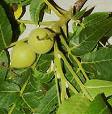Texas Black Walnut Tree Information
Images of Texas Black Walnut:






Texas Black Walnut grows in the following 7 states and provinces:
Arizona, Colorado, Kansas, Maine, New Mexico, Oklahoma, TexasInformation about Texas Black Walnut:
The Juglans Microcarpa is commonly known as the Dwarf Walnut, Little Walnut, Mexican Walnut, Namboca, Nogal, Nogalillo, Nogalito, River Walnut, Texas Black Walnut, Texas Walnut as well as Walnut.
The currently accepted scientific name of little walnut is Juglans microcarpa Berl. . Two varieties are delineated on the basis of morphological differences such as leaf and fruit size . The following varieties are commonly recognized : Juglans microcarpa var. microcarpa Juglans microcarpa var. stewartii Little walnut hybridizes with the closely related Arizona black walnut (Juglans major) , and populations which exhibit various intermediate characteristics have been reported . At the eastern edge of its range, little walnut intergrades with black walnut (J. nigra) .Little walnut grows from southwestern Kansas through Oklahoma to central New Mexico and Texas, south into northeastern Mexico . In Texas, little walnut grows from the valley of the Colorado River west to the mountains of the Trans-Pecos . The variety stewartii grows in the Chisos Mountains of Texas and extends into Mexico .Texas walnut occurs abundantly in a number of riparian woodland communities. It is included as a dominant or indicator in the following community type (cts) classifications: Area Classification Authority TX: Brewster Co. general veg. cts Carignan 1988 NM, TX: Guadalupe general veg. cts Gehlbach 1967 Escarpment Southwest riparian cts Szaro 1990a Southwest riparian cts Szaro 1990b TX: Brewster Co. general veg. cts Denyes 1956Some of the information provided here is attributed to:Tirmenstein, D. A. 1990. Juglans microcarpa. In: Fire Effects Information System, [Online]. U.S. Department of Agriculture, Forest Service, Rocky Mountain Research Station, Fire Sciences Laboratory (Producer). , available at the USDA Fire Effects Information System (FEIS) website